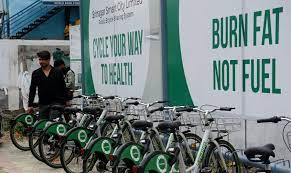Srinagar Smart City Bicycle Project: Why the Public Bike-Sharing Scheme Failed
By: Javid Amin | Srinagar | 06 Aug 2025
A Pedal Toward Progress
When the Srinagar Smart City bicycle project was launched with much fanfare and the catchy slogan “Burn Fat, Not Fuel,” it promised to usher in a new era of sustainable mobility. For a city battling air pollution, rising traffic congestion, and a lack of recreational infrastructure, the idea of a tech-enabled public bike-sharing system felt revolutionary. The green-colored bicycles, docked neatly in dedicated stations, painted a hopeful picture of a healthier, more eco-conscious Srinagar.
But just a couple of years later, that promise lies in tatters. The bikes are now rusting, their docks broken, and the app-based access system barely functional. What went wrong? Why did a project designed for public good fall so spectacularly short?
This longform investigative article dives deep into the story of the Srinagar Smart City bicycle project—from its idealistic beginnings to its derelict present—examining how flawed planning, poor execution, and lack of civic engagement turned a smart idea into a forgotten relic.
The Vision That Inspired a City
The idea of a public bicycle-sharing system was part of the broader Smart City Mission launched by the central government to modernize urban infrastructure and services. Srinagar, included in this mission, envisioned a mobility solution that would:
- Reduce traffic congestion
- Improve air quality
- Offer a healthy, affordable transport option
- Encourage a shift from fossil fuel dependence
Planned as a component of the Srinagar Smart City project, the bicycle scheme was launched in partnership with a private vendor, with crores of rupees invested in buying bicycles, creating digital docking stations, and developing an app-based rental service.
For a while, the buzz was real. Influencers took selfies with the bikes. Government officials held photo-ops. Students and young professionals registered to use the app. The city appeared to be pedaling toward a greener future.
The Cracks Begin to Show
As the novelty faded, the problems began surfacing:
- Poor Infrastructure: Srinagar’s roads were never truly prepared to host cyclists. Existing cycling tracks were incomplete or taken over by street vendors. There was no demarcation or safety buffer for bikers.
- Tech Accessibility Issues: The digital registration process was cumbersome. Many users, especially the elderly or less tech-savvy, struggled to navigate the app. QR-code based unlocking of bikes became an obstacle instead of a convenience.
- Zero Promotion and Public Awareness: No sustained campaigns were conducted to educate citizens about the benefits of cycling. No events, no school programs, no community rides. Without public ownership, the scheme remained alien to most locals.
- Neglected Maintenance: Bikes started developing mechanical issues—jammed chains, broken pedals, deflated tires. The docks were vandalized or malfunctioning. Complaints were ignored, and repairs were sporadic at best.
Within months, what was meant to be a symbol of smart urban living started looking like an urban junkyard.
Ground Reports and Citizen Disillusionment
A video report by Greater Kashmir in early 2025 captured the mood on the ground. Bicycles were seen lying sideways on sidewalks, some missing parts, others rusting in the rain. Docks stood empty or broken, with no support in sight. Locals interviewed expressed frustration and confusion.
“We were told it was a world-class initiative. But who is using it now?” asked a shopkeeper near Lal Chowk.
“I tried the app thrice, but it kept crashing. I gave up,” said a college student from Bemina.
There were also safety concerns. With no protected lanes, cyclists found themselves weaving through traffic, honked at, and occasionally hit by reckless drivers. For women and children, it simply didn’t feel safe.
The Accountability Void
One of the most glaring gaps in the Srinagar Smart City bicycle project was the absence of a transparent accountability framework. Who was responsible for:
- Regular bike maintenance?
- Dock repairs?
- App glitches?
- Community outreach?
- Financial audits?
When local journalists filed RTIs (Right to Information requests), they were met with bureaucratic ambiguity. Multiple departments passed the buck. The vendor blamed the government. The government cited lack of public participation.
This finger-pointing culture ensured that no one took ownership, even as public funds were drained.
Comparing with Successful Models
It’s not that bicycle-sharing can’t work. Cities like Amsterdam, Copenhagen, even closer home—Bengaluru and Pune—have successfully implemented public cycling programs. Their success hinges on:
- Strong policy backing
- Dedicated, safe infrastructure
- Simple user interfaces
- Community-led cycling culture
These cities treat bicycles as part of their urban DNA. In contrast, Srinagar’s model felt imposed—technology-first, people-later.
The Environmental Irony
Ironically, the failed bicycle project now contributes to the very problems it sought to solve:
- Abandoned bikes and docks clutter public spaces
- Rusting metal pollutes the environment
- Unmaintained structures pose safety hazards
The dream of reducing emissions and traffic has flipped into a case study in wasteful planning. Crores were spent, but air quality remains poor, and traffic congestion continues unabated.
Lessons Not Yet Learned
What Srinagar’s Smart City bicycle project reveals is a deeper malaise in urban governance:
- Projects are announced with buzzwords, but without groundwork.
- Public money is spent on infrastructure without long-term planning.
- Citizen feedback is ignored until it’s too late.
- Accountability frameworks are missing.
This isn’t just about bikes. It’s about how cities dream, plan, execute—and fail.
What Needs to Happen Now
The failure is not irreversible. But it requires bold corrective steps:
- Comprehensive Audit: A third-party audit of funds, infrastructure, and contracts.
- Repair and Reuse: Fix or repurpose usable bicycles; scrap the unusable ones sustainably.
- Community Involvement: Form cycling clubs, school-based programs, and public consultations.
- Simple Access Models: Replace the broken app with kiosk-based rentals or OTP-based systems.
- Dedicated Cycling Tracks: Build safe, protected lanes as a priority before relaunch.
- Regular Maintenance Plans: Clear roles, budgets, and timelines for upkeep.
Bottom-Line: Hope is a Wheel That Can Turn Again
Srinagar’s bicycle dream doesn’t have to end in rust. With honest introspection, people-first planning, and civic accountability, the city can reboot this vision. Sustainable mobility is not a luxury—it’s a necessity.
As the climate crisis looms larger, and urban spaces become more congested, solutions like public cycling aren’t just nice to have—they are urgent. The failure of the Srinagar Smart City bicycle project should be a wake-up call, not a death sentence.
Because a smart city isn’t one with the fanciest tech—it’s one that listens, adapts, and puts its people first.




